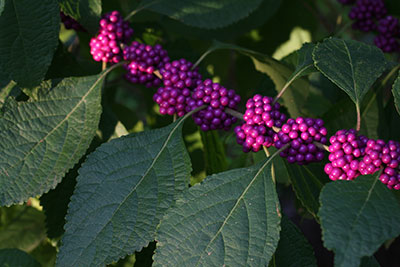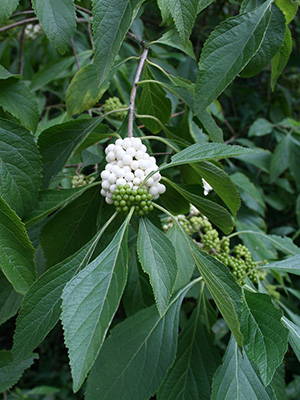Beautyberry
If you’re looking for a dazzling plant to attract birds to your yard, look no further than beautyberry.

This Florida native shrub has striking, bright purple fruits that add jubilant color to the landscape. Beautyberry (Callicarpa americana) can be found growing in hammocks and woodland areas. In the garden, this Florida-Friendly option works well as a specimen plant and blends nicely in forested areas.
Characteristics
Beautyberry is a sprawling shrub reaching 3 to 8 feet tall and 4 to 8 feet wide. It forms a rounded shape with branches arching toward the ground. The deciduous leaves are light green, coarse and fuzzy.
Small, pale lavender-pink flowers appear along the branches from spring to summer and then mature into jewel-like fruits by September. The showy clusters of shiny purple fruits are densely packed and encircle the woody stems. If not devoured first by birds or small mammals, the fruits will remain for several weeks after the plant drops its leaves, staying on as black dried fruits.
Beautyberry fruits are in fact edible for humans, but not very palatable. Many argue that when eaten fresh they are quite dull in flavor and dry out the mouth. With that being said, the taste of the fruits can be bolstered with sugar by making them into a jelly or preserve. The plant has other uses too; according to the USDA, in 2006 scientists extracted chemical properties from beautyberry leaves that were proven to be a successful skin repellant for ticks and mosquitoes.
Fun fact — the fruits on beautyberry are not actually berries but drupes. Fruits defined as drupes contain one to several seeds with each seed enclosed in a hard encasing (endocarp). Berries, on the other hand, contain numerous seeds that are not enclosed in an endocarp.

If you are looking for a different color scheme, the Callicarpa americana var. lactea has white, pearlescent fruit. The cultivar ‘Russell Montgomery’ also sports white berries.
In addition to C. americana, several other species of beautyberry will grow well in Florida. Callicarpa japonica, native to China and East Asia, typically has purple fruit and a growth habit of 4 to 6 feet in height and width. The C. japonica cultivar ‘Leucocarpa’ has white fruit. Another Asian species, C. dichotoma, has smaller leaves and is more compact, at 2 to 4 feet tall and wide. It also has a white-fruited cultivar, called ‘Albifructus’.
In terms of size, C. americana has the largest fruit (4-5 mm in diameter). The drupes of C. japonica are slightly smaller (2-3 mm in diameter), while those of C. dichotoma are much smaller (1-2 mm in diameter).
Planting and Care

Beautyberry does well throughout Florida; you can plant it any time during the year in USDA Hardiness Zones 8a to 10b. This shrub is drought tolerant once established, so it thrives during the summer heat. It fruits best in full sun but can also grow in heavy or filtered shade. Beautyberry prefers well-drained, rich soil, but will also grow in poor, sandy soil. It should not be grown in coastal areas, as it is not salt tolerant.
This shrub fits nicely amongst other native plants such as firebush and native coffee, and works well in naturalized, woody areas. Its stand-out fruits make it a perfect specimen plant and provide ample bird-watching opportunities.
For best fruiting in the following year, prune anytime between late fall and late winter. Then allow for maintenance shaping if needed to keep it within bounds, keeping in mind this might lower the amount of fruit produced. C. americana is readily available and now quite common in retail nurseries and native plant nurseries.
Beautyberry is the whole package: easy to care for, attractive and wildlife friendly. This native shrub could be just what you are looking for!
